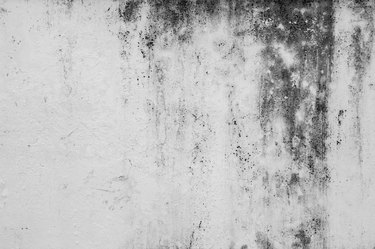
Mold is a type of fungus, although it's one that doesn't sprout fruiting bodies, like mushrooms. When you see a mold colony growing on a concrete floor, what you're looking at is a mycelium: a closely knit network of living filaments. Each of the nodes of this network has roots that reach into the concrete, and if you want to eradicate the colony, you have to kill the roots.
The most effective way to do this is to deprive them of moisture, but that's hard to do if the concrete is outside. The next best approach is to physically remove the mold, roots and all. Oft-recommended chemical mold killers, such as bleach and vinegar, probably won't be as helpful as you expect.
Video of the Day
Video of the Day
The Best Mold Root Killer
Professionals usually recommend using bleach to kill mold on household surfaces, but the truth is that this only works on nonporous surfaces, and concrete is far from nonporous. The high surface tension of chlorine bleach prevents it from seeping into the pores, and while it will kill the mold on the surface, the chlorine evaporates quickly while the water soaks in and actually feeds the roots. The result is that the mold can grow back with a vengeance.
Vinegar is another disinfecting agent that can kill mold roots, but it's an acid that can etch the surface of a concrete pad and should be used sparingly. The best way to kill mold is to scrub with good old soap and water. Besides being the method recommended by the Environmental Protection Agency, scrubbing with soap and water is the method least likely to damage the concrete. For outdoor surfaces, like driveways and concrete walls, a really strong detergent, such as trisodium phosphate (TSP), may be in order but be sure to wear rubber gloves and eye protection.
Scrub the Mold
The key to effective mold removal is to physically remove as much of it as possible. With that in mind, mix a soap solution consisting of an ounce or two of a strong liquid cleaner (or 1/2 cup TSP) per gallon of water and go to work with a scrub brush. Douse the mold-infested area, work it over until all the discoloration is gone and then rinse the area with clean water. If you're cleaning a large portion of a pad or driveway, you may want to scrub with a stiff push broom to avoid getting on your hands and knees.
When the area dries out, keeping it dry is the best way to prevent the mold from coming back. Indoors, that may mean running a fan or dehumidifier in the room. Outdoors, it may mean finding a way to shelter the mold area from rain.
Use a Power Washer
A power washer can be a powerful mold-killing tool for outdoor surfaces. The pressurized jet of water can reach deep into the pores to dislodge mold roots and blow them away.
For best results, fill your power washer's soap reservoir with a strong detergent and soap down the area at a low pressure before blasting away with clean water. Use a yellow or green tip on the power washer (15 or 25 degrees, respectively) or a turbo tip. Keep the pressure under 2,000 psi and the tip at least 6 inches from the concrete to avoid damaging the surface. Keep spraying until all the discoloration is gone and be prepared to repeat the treatment if the mold reappears.